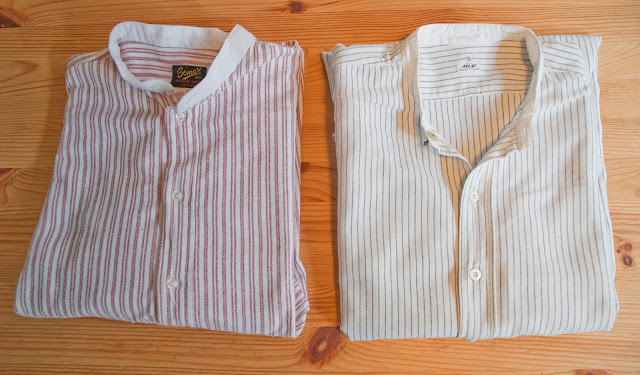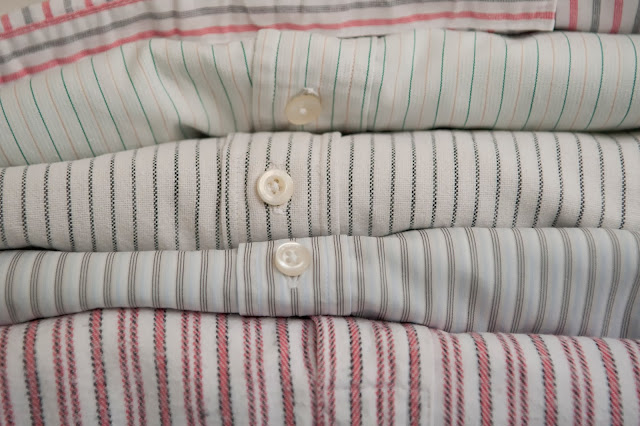Collarless (Neck Band) Shirts.
 |
| A vintage striped cotton work shirt dating from c1920s. |
Around the 1840's baggy square cut shirts, with high attached collars and frilled cuffs, were ditched in favour a more austere form of shirt. Thus the collarless shirt came in to being.
The neck band shirt was a fixture of the working mans' wardrobe for many years. These shirts, normally made from stripe brushed or flannelette heavy cotton, were fabricated to last.
 |
| Two heavy flannelette examples. The early ones can be quite rough... The solution? I suggest long under garments. |
Whereas the more formal poplin business shirts were usually white, work shirts were either coloured or rather gaudily striped. Interestingly, until roughly the 40's shirts were regarded as a second layer of underwear - not something that one should prominently display, as today. All that would have been visible were cuffs, (separate) stiff collar, and a couple of inches of fabric barely visible above the top button of the waist-coat either side of a tie.
 |
| Shirts were not mass produced. Normally made by a local tailor, or in some cases by the women of a working family, they came in a wide variety of colours. |
Men would have had few shirts and separate collars were a way of prolonging its life. The shirt may have been filthy (the colours hid the dirt better), but collars were easy to launder and cheaper to replace. Depending on the trade you were in collar & tie might not have been worn at all during the week, but saved for Sunday best. (That said, I was once robustly told off by the haughty proprietress of a vintage shop in the Kings Road for not wearing a collar & tie!)
 |
| Some later shirts had softer detachable collars. A step forward in comfort... |
Most shirts sported a half placket opening, meaning that it was pulled on over your head. Fully button through shirts did not come into fashion until the 1950's.
The tails were cut generously long. This, combined with trouser waist lines that hovered dangerously near the nipple, meant that one's shirt, once tucked in, stayed tucked.
As waistlines dropped so did the placket until button through, or coat shirts (because you donned them as you would a coat) became the prevalent style.
 |
| This example sports double cuffs & a reinforced front or "bib". |
Cuffs were normally single and button through, though as with the example above shirts for "best" would have had double cuffs and perhaps be fashioned from a lighter cotton, as here.
 |
| A heavy flannelette shirt with additional cotton lining. This Somax shirt is actually quite modern. I found it languishing as dead stock in the corner of a sadly now defunct gents outfitters in Whitstable, Kent. It's now been turned in to a Costa Coffee... |
In addition to the heavy weight fabric needing to be durable for work, the fact of their construction meant that these shirts last for years - important if you couldn't afford to replace them. Remember too that almost all houses were coal fire heated, and in the case of working mens quarters, cheaply built and drafty.
I love this type of shirt. I wear them regularly and feel that they still deserve a place in any man's wardrobe. The heavier versions are immensely warm, and worn sans collar are very comfortable. Combined with a round point stiff collar they can look particularly dapper. (More on the important topic of collars and their nearly endless variants later.)
If not able to raid your great uncle's armoire fear not, you can invest in a high quality reproduction at
Darcy Clothing. I found most of my original examples at
Old Hat in Fulham, London. Run by tailor David Saxby, this place is a treasure trove of vintage mens apparel.







No comments:
Post a Comment